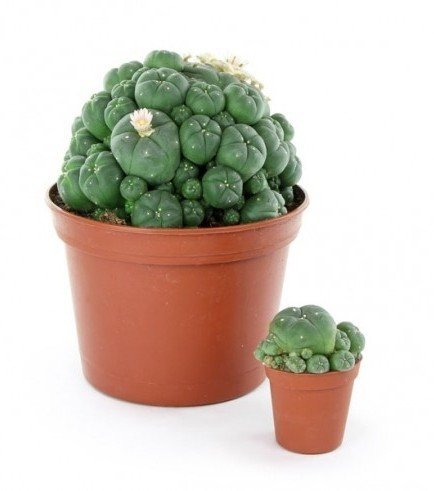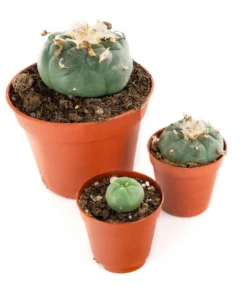Peyote Cactus
$170.00 – $1,100.00
Peyote is a small, button shaped cactus native to the southern parts of the United States. Potent compounds in the plant, such as mescaline, cause it to have a hallucinogenic effect in humans.
Peyote Cactus Available for Purchase Online – Exotic and Rare Psychedelic Plant
Peyote cactus, scientifically known as Lophophora williamsii, is a small, spineless cactus native to the southern parts of the United States and Mexico. It is known for containing psychoactive alkaloids, particularly mescaline. The peyote cactus is often used for its hallucinogenic effects and is considered a sacred plant in some indigenous cultures. However, it is important to note that the use and possession of peyote is illegal in many countries, including the United States, except for certain religious and cultural exemptions. The peyote cactus is endangered in the wild, and efforts are being made to protect and preserve its natural habitat.
Origins and Description Peyote cactus is a small, button-shaped cactus that belongs to the family Cactaceae. It has a distinctive appearance with a low, rounded shape and is typically spineless. The crown of the cactus may be chewed or soaked in water to make a tea for consumption.
Effects and Uses The main psychoactive compound in peyote is mescaline, which produces hallucinogenic effects. When consumed, peyote can induce altered states of consciousness, visual and auditory hallucinations, and changes in perception and mood. It is often used in religious and spiritual ceremonies by certain indigenous cultures for its perceived spiritual and healing properties.
Risks and Precautions While peyote has been used for centuries in certain cultural contexts, it is important to approach its use with caution. The psychoactive effects of peyote can be intense and may have both short-term and long-term psychological effects. Some potential risks and precautions associated with peyote use include:
-
Psychological effects: Peyote can induce intense and unpredictable psychological experiences, including hallucinations and altered states of consciousness. These effects can vary from person to person and may be influenced by factors such as mindset, setting, and dosage.
-
Physical effects: Peyote can also cause physical effects such as increased heart rate, elevated blood pressure, dilated pupils, and changes in body temperature. It may also lead to nausea, vomiting, and other gastrointestinal discomfort.
-
Legal status: In many countries, including the United States, the possession and use of peyote are illegal, except for specific exemptions for religious and cultural practices. It is important to be aware of the legal implications before considering the use of peyote.
-
Endangered status: The peyote cactus is listed as an endangered species due to overharvesting and habitat destruction. It is crucial to support conservation efforts and sustainable practices to protect the plant and its natural habitat.
Conclusion Peyote cactus is a small, spineless cactus that contains the psychoactive alkaloid mescaline. It is known for its hallucinogenic effects and is used in religious and spiritual ceremonies by certain indigenous cultures. However, the use and possession of peyote are illegal in many countries, and it is important to approach its use with caution due to potential risks and legal implications. Efforts are being made to protect and preserve the endangered peyote cactus and its natural habitat.
What to know about peyote
The peyote cactus, or Lophophora williamsii, gets its common name from the Nahuatl language. The plant is a small, button shaped cactus that grows predominantly in Mexico and the southern parts of the U.S.
Native Americans have known of the plant’s hallucinatory properties for thousands of years, and peyote still holds a sacred place in these cultures. In fact, over 40 tribes in North America and Western Canada still use it in sacred religious ceremonies.
To those who view peyote as sacred, the experience with this plant is a sort of communion or religious sacramentTrusted Source. The ritual varies from tribe to tribe and may include other practices, such as meditation, chanting, or various cleansing ceremonies.
Even the process of acquiring the peyote, called “the hunt,” is a part of the ritual. In the past, some Native Americans would travel up to 322 kilometers (200 miles) on foot to attain the peyote.
Since its scientific discovery around the turn of the 20th century, peyote use has expanded. Now, many people use the plant or its extracts recreationally.
Although peyote has historically had spiritual and ritualistic uses — among Native Americans, in particular — today, many people also use the plant recreationally. Peyote may also have some health benefits, but research is still in its early stages. Peyote and mescaline both carry risks, and some people may experience side effects after ingesting the plant.
How does it work?
Taking whole peyote or the active alkaloid mescaline produces the psychedelic effects associated with the plant.
Mescaline interacts with the 5-HT2A receptors in the brain, which pertain to how the body uses serotonin. These receptors are also the targets of other classic hallucinogens, such as LSD and psilocybin mushrooms. They are likely responsible for the “trip” a person experiences when using these substances.
People can ingest mescaline in several ways. Eating the dried crowns of the peyote cactus, boiling the cactus to make tea, and taking capsules containing peyote or mescaline are all common ways. There are also synthetic forms of mescaline, which are generally available in the form of capsules.
An exact dosage is difficult to quantify, as the plants themselves vary in potency when a person picks them.
Once a person ingests it, the body absorbs mescaline rather quickly. The effects may begin in under an hour and can last for around 12 hoursTrusted Source. As the body breaks down the mescaline, the effects wear off.
The peyote cactus is a classic hallucinogen in the same class as LSD, which has led to much of the controversy surrounding it.
A person who takes peyote will likely have a psychedelic or hallucinogenic trip. Mescaline, which is the psychoactive component in peyote, is responsible for this effect.
The effects will be different for everyone, though most people experience vivid hallucinations.
These hallucinations may affect multiple senses, and many people describe the trips as involving a mixing of the senses. For example, people may claim to be able to “see sounds” or “feel colors.”
The hallucinogenic effects of mescaline also appear to enhance the senses. Colors, sounds, and even experiences may feel richer or bolder. Time may become distorted to some people. For others, the field of vision and objects within may shift or change.
Visions are common with mescaline, especially in higher doses. These visions are experiences that are not happening in the “real” world, but they will feel very real to the person experiencing them.
Visions may be either overwhelmingly joyful or terrifying. They may seem highly significant to the person, but they may also feel very chaotic.
Like other hallucinogens, mescaline may cause some people to have a “bad trip.” These may involve negative feelings, experiences, and emotions.
side effects
People take peyote for the hallucinogenic effect and trip, but the plant may also cause some physical reactions and adverse side effects.
Taking peyote may cause temporary reactions within the body, such as:
- increased heart rate
- numbness
- tension
- increased blood pressure
- fever
- chills
- muscle weakness
- headaches
- dilated pupils
- nausea
- vomiting
- sweating
- shivering
Potential health benefits
Various Indigenous cultures that revere the plant believe that it has a vast number of health benefits for the body. For example, they may use peyote to treat a number of ailments, from snake bites and wounds to systemic problems such as diabetes, skin conditions, and general pain.
The potential benefits may arise from the plant itself, the physical reaction the body has to the plant, or the experience that one has after ingesting the cactus.
That said, Western medicine does not back the majority of these claims, so researchers must continue to study these traditional uses of peyote and mescaline.
| QUANTITY | 2 grams, 5 grams, 10 grams, 1/2 ounce, 1 ounce |
|---|
Be the first to review “Peyote Cactus” Cancel reply
Related products
Magic Mushrooms
Magic Mushrooms
Anxiety
LSD Blotter Paper






















Reviews
There are no reviews yet.